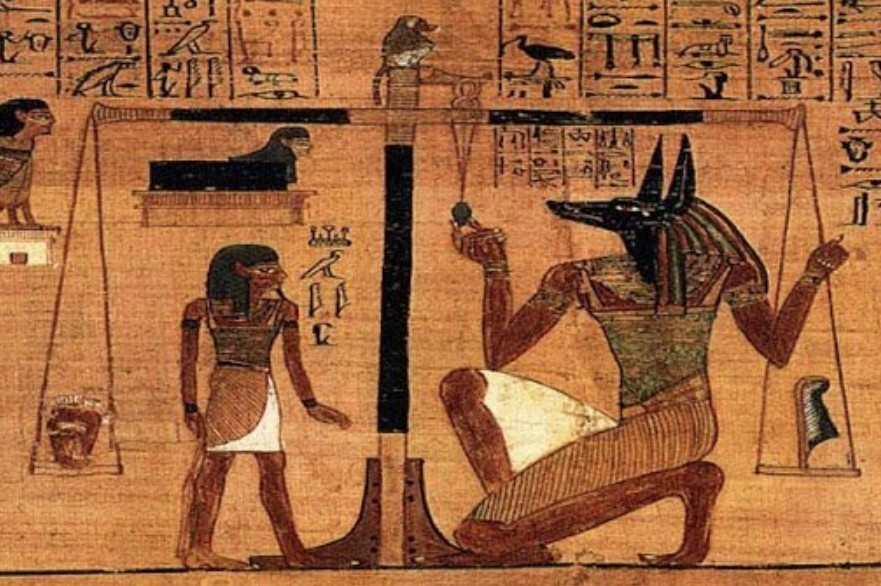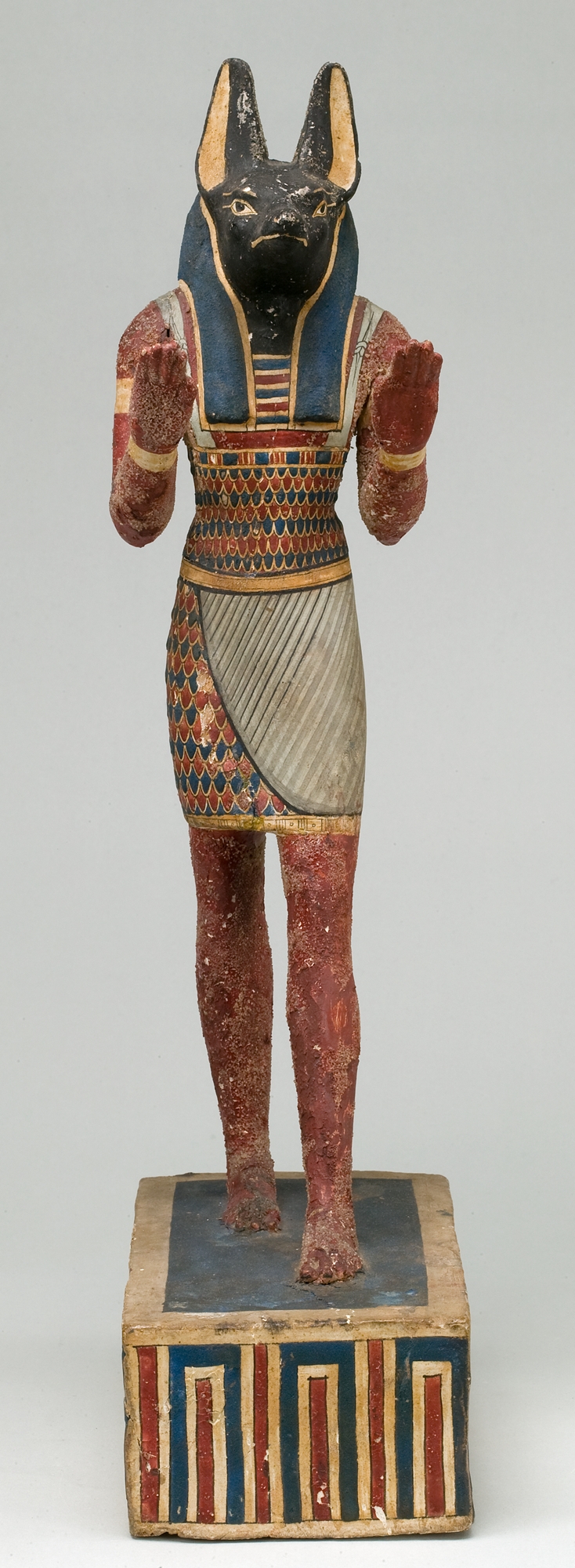
Bóg Anubis (starożytny Egipt) Historia powszechna
Cywilizacja, która fascynuje! Starożytny Egipt, choć istniał wiele wieków temu, do dziś pozostaje fascynujący. Patrzymy z podziwem dawną sztukę Egipcjan: skarby grobowca Tutenchamona, piramidy, Sfinks, grobowce faraonów, mumie czy piękne i ogromne posągi. Przez blisko 30 wieków, cywilizacja starożytnych Egipcjan była jedną z.

ArtStation Anubis, Richie mason Anubis, Egypt concept art, Ancient
Anubis, the Jackal god of Egyptian mythology, was lord of the afterlife, protector of the cemeteries, and war-prince son of Osiris the God-king. Worshipped across all of Egypt, he held a special place in the seventeenth nome, where he was the patron god and protector of the people. Priests of Anubis would perform the mummification rituals.

Anubis by PlumpOrange Ancient egypt art, Egyptian art, Ancient
Anubis as a jackal perched atop a tomb, symbolizing his protection of the necropolis. Anubis (/ ə ˈ nj uː b ɪ s /; Ancient Greek: Ἄνουβις), also known as Inpu, Inpw, Jnpw, or Anpu in Ancient Egyptian (Coptic: ⲁⲛⲟⲩⲡ, romanized: Anoup), is the god of funerary rites, protector of graves, and guide to the underworld, in ancient Egyptian religion, usually depicted as a canine.

anubis Of all the ancient Egyptian Gods Anubis is frequent… Flickr
Anubis weighing the soul of the scribe Ani, from the Egyptian Book of the Dead, c. 1275 bce. Anubis, ancient Egyptian god of funerary practices and care of the dead, represented by a jackal or the figure of a man with the head of a jackal. In the Early Dynastic period and the Old Kingdom, he enjoyed a preeminent (though not exclusive) position.
Starożytny Egipt Mosiężna Figurka Anubis Zwierząt • Cena, Opinie
Anubis (also known as Inpu, Inpw, Anpu) is the Egyptian god of mummification, funerary rites, guardian of tombs, and guide to the afterlife as well as the patron god of lost souls and the helpless. He is one of the oldest gods of Egypt, most likely developed from the earlier jackal god Wepwawet with whom he is often confused.. Anubis' image is seen on royal tombs from the First Dynasty of.

ArtStation Gods of Egypt Anubis Designs , Jerad Marantz Анубис
Anubis was the god of the dead and the underworld until the Middle Kingdom, when this role was taken over by Osiris. He is one of the oldest gods, references in text go back as far as the Old Kingdom. Anubis is the inventor and god of embalming and mummification. He guided the death through the underworld (called Duat).
Starożytny EGIPT nóż kamienny ANUBIS PIĘKNY! 8517946826
Anubis, Inpu, Anepu - w funkcji bóstwa związanego z kultem zmarłych, wcześniej aniżeli Ozyrys, występuje już od okresu Starego Państwa (czasami jako Chenty Imentiu ). Uczestniczył w sądzie zmarłego i opiekował się jego mumifikacją, był strażnikiem cmentarzy. Przedstawiany w postaci pewnej rasy psa (nie szakala, jak powszechnie.

Statuette of Anubis Ptolemaic Period The Metropolitan Museum of Art
#2 HIS MOST IMPORTANT ROLE WAS IN THE "WEIGHING OF THE HEART" Anubis played several roles in the Ancient Egyptian mythology. He was a protector of graves and cemeteries.As the dead were usually buried on the west bank of the Nile, Anubis was called khenty-imentiu, which means "foremost of the westerners".Anubis was associated with mummification due to which he was called jmy-wt, which.

FileAnubis standing.jpg Wikimedia Commons
Bóg Anubis. W okresie ptolemejskim (320-30 p.n.e.), kiedy greccy faraonowie zasiedli na tronie Egiptu, Anubis zjednoczył się z greckim bogiem Hermesem pod imieniem Hermanubis. Tych bogów łączyło to, że obaj towarzyszyli duszom zmarłych w zaświatach. Centrum kultu Hermanubisa było Kinopolis (po grecku - „miasto psów").

Pin na Szkic
Egipt starożytny, w przeciwieństwie do współczesnej Republiki Egiptu, to niemal wyłącznie dolina i delta Nilu. Rozległe pustynie (Arabska i Libijska), poza wielkimi oazami, nigdy nie stanowiły z nim jedności politycznej, kulturowej czy gospodarczej. W starożytności dorzecze Nilu geograficznie i historycznie dzieliło się na Egipt.

What's Your Ancient Egyptian Horoscope Sign? Conscious Reminder
Warto wspomnieć, że mieszkające w egipskich domach wielopokoleniowe rodziny dzieliły swoje cztery kąty ze zwierzętami, zarówno domowymi (kot odstraszał gryzonie, a pies strzegł domostwa i/lub pomagał w polowaniach), jak i gospodarczymi. Egipskie elity miały do dyspozycji znacznie większą przestrzeń życiową.

Statuette of Anubis Ptolemaic Period The Met
Anubis - w egipskiej mitologii bóg o głowie szakala, ściśle łączony z mumifikacją i życiem pozagrobowym. W języku Starożytnego Egiptu był znany jako Inpw. Najstarsza znana wzmianka o nim pochodzi z tekstów piramid z okresu Starego Państwa, gdzie łączony jest z pogrzebem faraona. W tej epoce był najważniejszym bogiem związanym ze śmiercią, lecz w Średnim Państwie.

Sztuka egipska by Maciek on Tatuaż dłoń in 2020 Starożytny egipt
W tym materiale przyjrzymy się Anubisowi, tajemniczemu oraz najbardziej introwertycznemu bogowi z mitologi Starożytnego Egiptu. Poznamy jego historie z staro.

Obraz na płótnie Starożytny Egipt. Anubis bóg z głową szakala
The word "Anubis" is actually a Greek word. The Egyptian word for "Anubis" is " Anpu" or " Inpu". In ancient Egypt, the word "Anpu" meant "deterioration and death". It is also signified darkness and black, and mystery. Anubis was reputed as the Lord of the Necropolis (a site that housed the dead - cemetery).

Richie Jon Mason on Twitter Ancient egypt art, Egypt concept art
Starożytny Egipt, kultura i religia. Cywilizacja starożytnego Egiptu przetrwała około 30 wieków — od 30 wieku p.n.e. do 30 r. p.n.e., kiedy to stało się częścią Cesarstwa Rzymskiego. Egipt był znaczący ze względu na swoją wielkość i długowieczność, zachowując silną potęgę kulturową pomimo kilku okresów zamieszek.

starożytny egipt bogowie fantastyka Szukaj w Google Anubis and
15 Bogów i Bogiń Starożytnego Egiptu. Zaktualizowano 23 lipca 2019 r. Bogowie i boginie starożytnego Egiptu przynajmniej częściowo przypominali ludzi, a także zachowywali się trochę jak my. Niektóre bóstwa miały cechy zwierzęce - zazwyczaj ich głowy - na szczycie ludzkich ciał. Różne miasta i faraonowie faworyzowali swój.